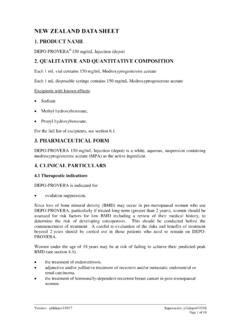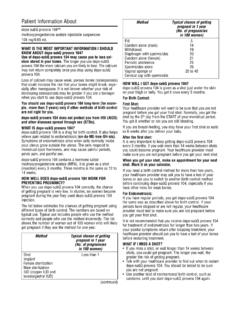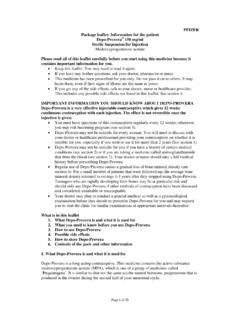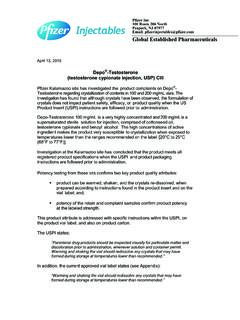Transcription of NEW ZEALAND DATA SHEET - Medsafe
1 Version: pfddepli10718 Supersedes: pfddepli10218 Page 1 of 25 NEW ZEALAND DATA SHEET 1. PRODUCT NAME depo - medrol with lidocaine (methylprednisolone acetate (40 mg/mL), lidocaine hydrochloride monohydrate (10 mg/mL)) (depot) 2. QUALITATIVE AND QUANTITATIVE COMPOSITION Each 1 mL vial contains 40 mg/mL methylprednisolone acetate and 10 mg/mL lidocaine hydrochloride. Excipient with known effect benzyl alcohol. For the full list of excipients, see section 3. PHARMACEUTICAL FORM Injection (depot): white, aqueous, sterile suspension. 4. CLINICAL PARTICULARS Therapeutic indications depo - medrol with lidocaine by intra-articular or soft tissue administration (including periarticular and intrabursal) is indicated as adjunctive therapy for short-term administration (to tide the patient over an acute episode or exacerbation) in: Synovitis of osteoarthritis Rheumatoid arthritis Acute gouty arthritis Epicondylitis Acute nonspecific tenosynovitis Post-traumatic osteoarthritis Acute and subacute bursitis depo - medrol with lidocaine may also be useful in cystic tumours of an aponeurosis or tendon (ganglia).
2 Version: pfddepli10718 Supersedes: pfddepli10218 Page 2 of 25 Dose and method of administration Dose Because complications of treatment with glucocorticoids are dependent on the size of the dose and the duration of treatment, a risk/benefit decision must be made in each individual case as to dose and duration of treatment and as to whether daily or intermittent therapy should be used. The lowest possible dose of corticosteroid should be used to control the condition under treatment and when reduction in dosage is possible, the reduction should be gradual. Because of possible physical incompatibilities, depo - medrol with lidocaine sterile aqueous suspension (methylprednisolone acetate) should not be diluted or mixed with other solutions.
3 When multidose vials are used, special care to prevent contamination of the contents is essential (see section ). Parenteral drug products should be inspected visually for particulate matter and discolouration prior to administration whenever solution and container permit. Sterile technique is necessary to prevent infections or contamination. depo - medrol with lidocaine may be used by any of the following routes: intra-articular, periarticular, intrabursal, intralesional and into the tendon sheath. It MUST NOT be used by the intrathecal, epidural or intravenous routes (see sections , and ). Administration for Local Effect Therapy with depo - medrol with lidocaine does not obviate the need for the conventional measures usually employed.
4 Although this method of treatment will ameliorate symptoms, it is in no sense a cure and the steroid has no effect on the cause of the inflammation. 1. Rheumatoid and Osteoarthritis The dose for intra-articular administration depends upon the size of the joint and varies with the severity of the condition in the individual patient. In chronic cases, injections may be repeated at intervals ranging from one to five or more weeks, depending upon the degree of relief obtained from the initial injection. The doses in the following table are given as a general guide: Version: pfddepli10718 Supersedes: pfddepli10218 Page 3 of 25 Size of Joint Examples Range of Dosage Large Knees, Ankles, Shoulders 20-80 mg Medium Elbows, Wrists 10-40 mg Small Metacarpophalangeal Interphalangeal Sternoclavicular Acromioclavicular 4-10 mg Procedure It is recommended that the anatomy of the joint involved be reviewed before attempting intra-articular injection.
5 In order to obtain the full anti-inflammatory effect, it is important that the injection be made into the synovial space. Employing the same sterile technique as for a lumbar puncture, a sterile 20 to 24 gauge needle (on a dry syringe) is quickly inserted into the synovial cavity. Procaine infiltration is elective. The aspiration of only a few drops of joint fluid proves the joint space has been entered by the needle. The injection site for each joint is determined by the location where the synovial cavity is most superficial and most free of large vessels and nerves. with the needle in place, the aspirating syringe is removed and replaced by a second syringe containing the desired amount of depo - medrol with lidocaine .
6 The plunger is then pulled outward slightly to aspirate synovial fluid and to make sure the needle is still in the synovial space. After injection, the joint is moved gently a few times to aid mixing of the synovial fluid and the suspension. The site is covered with a small sterile dressing. Suitable sites for intra-articular injection are the knee, ankle, wrist, elbow, shoulder, phalangeal, and hip joints. Since difficulty is occasionally encountered in entering the hip joint, precautions should be taken to avoid any large blood vessels in the area. Joints not suitable for injection are those that are anatomically inaccessible, such as the spinal joints and those like the sacroiliac joints that are devoid of synovial space.
7 Treatment failures are most frequently the result of failure to enter the joint space. Little or no benefit follows injection into surrounding tissue. If failures occur when injections into the synovial spaces are certain, as determined by aspiration of fluid, repeated injections are usually futile. Local therapy does not alter the underlying disease process and, whenever possible, comprehensive therapy including physiotherapy and orthopaedic correction should be employed. Following intra-articular corticosteroid therapy care should be taken to avoid overuse of joints in which symptomatic benefit has been obtained. Negligence in this matter may permit an increase in joint deterioration that will more than offset the beneficial effects of the steroid.
8 Unstable joints should not be injected. Repeated intra-articular injection may in some cases result in instability of the joint. X-ray follow-up is suggested in selected cases to detect deterioration. If a local anaesthetic is used prior to injection of depo - medrol with lidocaine , the anaesthetic package insert should be read carefully and all the precautions observed. Version: pfddepli10718 Supersedes: pfddepli10218 Page 4 of 25 2. Bursitis The area around the injection site is prepared in a sterile way and a wheal at the site made with one percent procaine hydrochloride solution. A 20 to 24 gauge needle attached to a dry syringe is inserted into the bursa and the fluid aspirated. The needle is left in place and the aspirating syringe changed for a small syringe containing the desired dose.
9 After injection, the needle is withdrawn and a small dressing applied. 3. Miscellaneous: Ganglion, Tendinitis, Epicondylitis In the treatment of conditions such as tendinitis or tenosynovitis, care should be taken, following application of a suitable antiseptic to the overlying skin, to inject the suspension into the tendon sheath rather than into the substance of the tendon. The tendon may be readily palpated when placed on a stretch. When treating conditions such as epicondylitis, the area of greatest tenderness should be outlined carefully and the suspension infiltrated into the area. For ganglia of the tendon sheaths, the suspension is injected directly into the cyst. In many cases a single injection causes a marked decrease in the size of the cystic tumour and may effect disappearance.
10 The dose in the treatment of the various conditions of the tendinous or bursal structures listed above varies with the condition being treated and ranges from 4 to 30 mg. In recurrent or chronic conditions, repeated injections may be necessary. The usual sterile precautions should be observed with each injection. Contraindications Systemic infections unless specific anti-infective therapy is given. Known hypersensitivity to methylprednisolone or any component of depo - medrol with lidocaine . Known hypersensitivity to lidocaine or other anaesthetics of the amide type Intravenous, intrathecal, epidural injection or any other unspecified route of administration. Administration of live or live, attenuated vaccines is contraindicated in patients receiving immunosuppressive doses of corticosteroids (see section , Immunosuppressive Effects/Increased Susceptibility to Infections).














